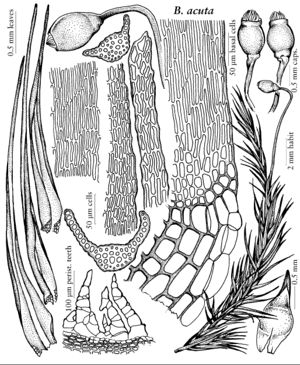familySeligeriaceae
genusBlindia
Show Lower Taxa
Blindia
Bryol. Europ. 2: 17. 1846,.
Etymology: For J. J. Blind, pastor at Münster, 1834–1848
| Taxon | Illustrator ⠉ | |
|---|---|---|
 | Blindia acuta | Patricia M. Eckel |
Plants of acidic rock, blackish. Alar cells colored and inflated. Sexual condition dioicous. Capsule smooth; annulus ill-formed; peristome teeth smooth. Calyptra cucullate.
Distribution
North America, Central America, Europe, Asia, Africa, Atlantic Islands (Iceland)
Discussion
Species 15 (1 in the flora).
Blindia is a small genus of acrocarpous, haplolepideous mosses, characteristically found on moist acidic rock substrates. Its peristome is defined by having the outer layer thicker than the inner and these are fused to form a single row of 16 papillose or smooth teeth. The significant gametophytic features are well-developed alar cells, smooth distal leaf cells, and subulate leaves, along with rheophytic or hygrophytic habitats.
Selected References
Lower Taxa
... more about "Blindia"
ill-formed +
clasping +
cucullate +
erect +
colored +
inflated +
not differentiated +
single +
homogenous +
long-excurrent +
curved +
generally erect-spreading;spreading-recurved +
linear;stoutly subulate +
haplolepideous +
absent +
reduced +
Bryol. Europ. +
acidic +
cygneous +
Blindia +
Seligeriaceae +
genus +
entire +
triangular +
unbranched;rarely 2-3-branched +
blackish +